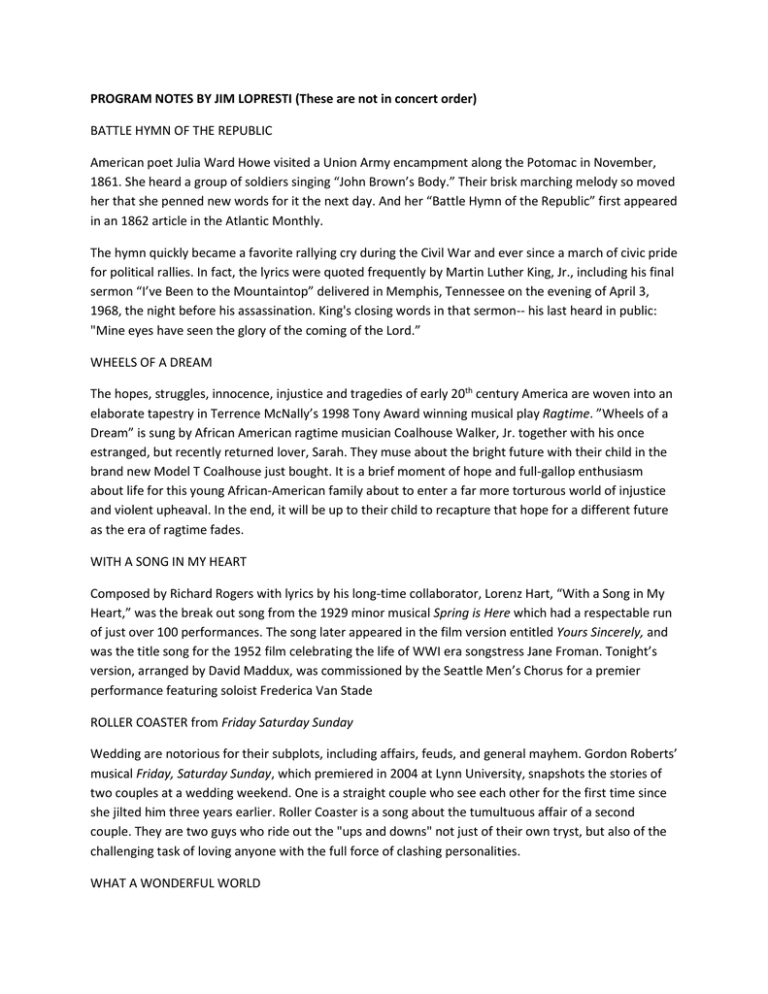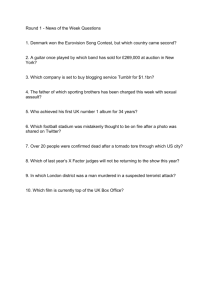PROGRAM NOTES BY JIM LOPRESTI (These are not in concert
advertisement

PROGRAM NOTES BY JIM LOPRESTI (These are not in concert order) BATTLE HYMN OF THE REPUBLIC American poet Julia Ward Howe visited a Union Army encampment along the Potomac in November, 1861. She heard a group of soldiers singing “John Brown’s Body.” Their brisk marching melody so moved her that she penned new words for it the next day. And her “Battle Hymn of the Republic” first appeared in an 1862 article in the Atlantic Monthly. The hymn quickly became a favorite rallying cry during the Civil War and ever since a march of civic pride for political rallies. In fact, the lyrics were quoted frequently by Martin Luther King, Jr., including his final sermon “I’ve Been to the Mountaintop” delivered in Memphis, Tennessee on the evening of April 3, 1968, the night before his assassination. King's closing words in that sermon-- his last heard in public: "Mine eyes have seen the glory of the coming of the Lord.” WHEELS OF A DREAM The hopes, struggles, innocence, injustice and tragedies of early 20th century America are woven into an elaborate tapestry in Terrence McNally’s 1998 Tony Award winning musical play Ragtime. ”Wheels of a Dream” is sung by African American ragtime musician Coalhouse Walker, Jr. together with his once estranged, but recently returned lover, Sarah. They muse about the bright future with their child in the brand new Model T Coalhouse just bought. It is a brief moment of hope and full-gallop enthusiasm about life for this young African-American family about to enter a far more torturous world of injustice and violent upheaval. In the end, it will be up to their child to recapture that hope for a different future as the era of ragtime fades. WITH A SONG IN MY HEART Composed by Richard Rogers with lyrics by his long-time collaborator, Lorenz Hart, “With a Song in My Heart,” was the break out song from the 1929 minor musical Spring is Here which had a respectable run of just over 100 performances. The song later appeared in the film version entitled Yours Sincerely, and was the title song for the 1952 film celebrating the life of WWI era songstress Jane Froman. Tonight’s version, arranged by David Maddux, was commissioned by the Seattle Men’s Chorus for a premier performance featuring soloist Frederica Van Stade ROLLER COASTER from Friday Saturday Sunday Wedding are notorious for their subplots, including affairs, feuds, and general mayhem. Gordon Roberts’ musical Friday, Saturday Sunday, which premiered in 2004 at Lynn University, snapshots the stories of two couples at a wedding weekend. One is a straight couple who see each other for the first time since she jilted him three years earlier. Roller Coaster is a song about the tumultuous affair of a second couple. They are two guys who ride out the "ups and downs" not just of their own tryst, but also of the challenging task of loving anyone with the full force of clashing personalities. WHAT A WONDERFUL WORLD Originally composed and released as a single performed by Louis Armstrong in 1968, the song gained only modest popularity in the US, most likely because of tepid promotion by ABC records. The opposite was true in the UK where it quickly rose to the top of the charts. A featured song in the popular 1988 movie, Good Morning Vietnam, it had a strong revival in 1988 and, re-released that year, quickly became an American favorite. In 1993 A unique ukulele medley version of “Wonderful World” was “mashed” with “Somewhere Over the Rainbow” by Hawaiian singer IZ Kamakawiwoʻole THE AWAKENING Joseph Martin, pianist, composer and director of Sacred Music publications for Shawnee Press is a minister’s son who said the following about himself in a recent interview with Wendy McKee, founder of Chicago’s professional women’s choral group, Brava: “I like writing with the purpose of meeting someone’s need through whatever gifts I have. On a personal level, it’s sort of like journaling your own life story or your faith journey. Some of my most important works have been me struggling with things I have experienced or celebrating the things that have been joys in my life. I want people to fall in love with what their own song can bring to their lives. I want them to enjoy discovering their musicianship, very much like I did.” His final words in “The Awakening” express that deeper intent: “Wherever emptiness is found, let there be joy and glorious sound. Let music never die in me. Forever let my spirit sing! Let all our voices join as one to praise the Giver of the Song. Let music live! Let music live!” DIAMONDS ARE A GIRL’S BEST FRIEND This classic song by Jule Styne and Leo Robin was first sung by Carol Channing in the 1949 Broadway production of Gentlemen Prefer Blondes, but is probably most remembered for Marilyn Monroe’s sultry performance as Lorelei Lee in the 1953 film version. The song has been performed and recorded by divas as diverse as Ertha Kitt, Ethel Merman, Julie London and even Emmy Lou Harris. Christina Aguilera performs it in her first film, Burlesque, and it was also featured with updated lyrics sung by Nicole Kidman in the 2001 hit film Moulin Rouge! AMERICA THE BEAUTIFUL Wellesley College English Professor Katherine Lee Bates was deeply moved by her 1893 cross country train trip to a summer teaching job in Colorado. She stopped in Chicago, city of “alabaster” for the World Columbian Exposition. She traveled across Kansas’ “amber waves of grain.” She eventually arrived at Pikes Peak, left in awe of the “purple mountains’ majesty.” She was later to write that is while atop the Colorado Rockies that the inspiration for the poem came to her. There were various attempts to match the poem to music, but it was eventually a hymn tune composed by New York church musician Samuel A Ward that was favored by most. Ward never came to know how popular his composition would become since it was first published seven years after his death. Ever popular to this day, there have been numerous appeals to US political leaders to raise it to at least equal, if not supplanting, status with the more military, and less “singable” current National Anthem. OVER THE RAINBOW Refusing to listen to Dorothy’s complaint about Miss Gulch’s shameful treatment of Toto, Auntie Em tells Dorothy to find herself “a place where you won't get into any trouble.” Dorothy muses to Toto "Someplace where there isn't any trouble? Do you suppose there is such a place, Toto? There must be. It's not a place you can get to by a boat, or a train. It's far, far away. Behind the moon, beyond the rain....." Judy Garland became ever identified with “Over the Rainbow” and its yearning for a life beyond strife and discord where the world is full of fabulous color instead of dismal black and white. Ironically, Harold Arlen and E.Y. Harburg’s most famous song from the 1939 film, The Wizard of Oz, was almost abandoned to the cutting room floor because Louis Mayer, MGM’s chief executive, complained that it slowed the action of the film. Fortunately he relented, and the rest is gay history. SINGING IN THE RAIN First performed in the 1929 Hollywood Music Box Revue, the song rather quickly became a hit and was recorded by a number of artists, including Jimmy Durante and Judy Garland. The song is certainly best known, however, for Gene Kelly’s exuberant puddle splashing performance in the 1952 film by the same name. In a far darker setting, the song accompanies a disturbingly violent scene in Stanley Kubrick’s A Clockwork Orange. And with a modern twist, “Singing in the Rain” made it to Fox’s Glee in a clever 2010 mash-up with Rihanna’s hit “Umbrella” featuring Gwyneth Paltrow. ______________________________ Program Notes by Lawrence Budmen (These have been edited to shorten, but not to change his wording and they are not in performance order) HALLELUJAH CHORUS, from CHRIST ON THE MOUNT OF OLIVES Ludwig van Beethoven (1770-1827) Christ on the Mount of Olives, with libretto by Franz Hubert, was composed in two weeks in the summer of 1801. It was first performed on April 5, 1803, together with the C Minor Piano Concerto and the Second Symphony at the Theater an der Wien. Beethoven revised the work in 1811 prior to its publication. Beethoven later became critical of the poet who was, nonetheless, considered to be one of the most popular librettists of Viennese opera at the time. Despite the lack of preparation at rehearsal, the performance was one of the rare successes Beethoven was to enjoy during his lifetime. This success had at least one immediate result, the commission to compose the opera Leonore, which eventually became Fidelio. The orchestration includes all winds and brasses with strings and large chorus, full richness and color. Concluding the oratorio, the “Hallelujah Chorus” displays the magnificence of the chorus and the rousing fervor of Beethoven’s mature style, prefiguring the finale of the opera Fidelio CORONATION MARCH from La PROPHETE Giacomo Meyerbeer was the father of French Opera, His five hour spectacles combined singing, dance, massive pageantry and historical drama on a scale that had not been previously attempted, even in the high Baroque extravagances of Lully and Rameau. Sheer expense and changing operatic taste eventually led to the disappearance of Meyerbeer’s operas from the international operatic repertoire. Still this iconic composer changed the face of opera. It would be difficult to imagine the music dramas of Richard Wagner or the late operas of Giuseppe Verdi without Meyerbeer’s visionary works La Prohete premiered at the Paris Opera in 1849. It is the tale of the Anabaptist movement’s struggle for power. Anabaptists leaders draft John of Leiden to stage a coup and become King of Munster. The blazing strains of the “Coronation March” accompany John’s coronation, a moment of celebration prior to the apocalyptic conclusion. The march’s central melody, with its spacious nobility, has been played by young musicians in high school and preparatory academy bands for generations NEW YORY, NEW YORK John Kander (b. 1927) John Kander has been a Broadway icon for nearly six decades. His many successful shows include Cabaret, Chicago, Zorba, Woman of the Year, and Kiss of the Spider Woman. Kander’s long collaboration with the late lyricist Fred Ebb also included numerous films and television special. Among the most notable was the score for Martin Scorsese’s 1977 film musical New York, New York. The tale of a complex partnership between a musician-band leader and female vocalist, the film starred Liza Minelli and Robert DeNiro. The title song became a staple of Minelli’s concert and night club performance. When Frank Sinatra recorded it, the song achieved international status. The city of New York even used this Kander favorite as theme music for a tourist promotion campaign. “New York, New York” has taken its rightful place in the Great American Songbook HUNGARIAN DANCE No 4 Johannes Brahms (1833-1897) Johannes Brahms loved the sound of the Hungarian instrumentalists and ensembles he heard in the many cafes in Vienna. In 1869 he wrote a set of 21 Hungarian Dances. Most of the melodies in these pieces are not direct quotations of Hungarian folk music; rather, they are Brahms’ original themes with a Hungarian twist. The dances were originally composed for piano duet. Eventually Brahms transcribed the first ten for solo piano. Later all the dances were arranged for orchestra although Brahms only orchestrated the last three of the set. The others were done by a variety of composers and conductors. The Hungarian Dance No 4 in F-sharp Minor was orchestrated by Paul Juon, a Russian trained musician who studied with Arensky and Taneyev, both Tchaikovsky pupils. With their mix of yearning sentiment and vivacious energy, these Brahms dances have proven some of the most popular and timeless in the repertoire, the melodies familiar far beyond the concert hall STAR SPANGLED SPECTACULAR George M. Cohan (1878-1942) The multitalented George M Cohan was a playwright, composer, lyricist, actor, song and dance man and producer. He produced 50 musicals, revues and plays, mostly his own original works, and composed over 500 songs. In the years after World War I, Cohan was known as “the man who owned Broadway.” At one point he had five productions running simultaneously. His life and career were memorialized in the film Yankee Doodle Dandy and the Broadway musical George M. “Star Spangled Spectacular” is a medley of six Cohan songs, including “Yankee Doodle Boy,” “Harrigan,” Mary’s a Grand Old Name” and “Grand Old Flag.” Cohan’s songs have journeyed beyond their Tin Pan Alley origins to become true American classics, staples of the pops concert repertoire and essential for any Fourth of July musical celebration.




